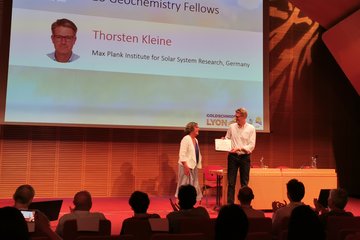Alle Typen
41.
Zeitschriftenartikel
Emission of solar chromospheric and transition region features related to the underlying magnetic field. Astronomy and Astrophysics 619, A5 (2018)
42.
Zeitschriftenartikel
Nature of the energy source powering solar coronal loops driven by nanoflares. Astronomy and Astrophysics 615, L9 (2018)
43.
Zeitschriftenartikel
Quasi-periodic Fast Propagating Magnetoacoustic Waves during the Magnetic Reconnection Between Solar Coronal Loops. The Astrophysical Journal Letters 868 (2), L33 (2018)
44.
Zeitschriftenartikel
Coronal Condensations Caused by Magnetic Reconnection between Solar Coronal Loops. The Astrophysical Journal Letters 864 (1), L4 (2018)
45.
Zeitschriftenartikel
A Cancellation Nanoflare Model for Solar Chromospheric and Coronal Heating. The Astrophysical Journal Letters 862 (2), L24 (2018)
46.
Zeitschriftenartikel
Observations of solar chromospheric heating at sub-arcsec spatial resolution. Astronomy and Astrophysics 617, A128 (2018)
47.
Zeitschriftenartikel
Solar Ultraviolet Bursts. Space Science Reviews 214, 120 (2018)
48.
Zeitschriftenartikel
Solar Coronal Loops Associated with Small-scale Mixed Polarity Surface Magnetic Fields. Astrophysical Journal, Suppl. Ser. 229, 4 (2017)
49.
Zeitschriftenartikel
Compact solar UV burst triggered in a magnetic field with a fan-spine topology. Astronomy and Astrophysics 605, A49 (2017)
50.
Zeitschriftenartikel
A closer look at a coronal loop rooted in a sunspot umbra. Astronomy and Astrophysics 587, A20 (2016)
51.
Zeitschriftenartikel
Limitations of force-free magnetic field extrapolations: Revisiting basic assumptions. Astronomy and Astrophysics 584, A68 (2015)
52.
Vortrag
Coronal loop footpoints threaded with small-scale mixed polarity surface magnetic fields. SOLARNET IV: The Physics of the Sun from the Interior to the Outer Atmosphere, Lanzarote, Spain (2017)
53.
Vortrag
Rotational motion in transition region loops. 8th Coronal Loops Workshop: many facets of magnetically closed corona, Palermo, Italy (2017)
54.
Vortrag
Signs of helical transition region loops embedded in filament channels. Rocks \& Stars II, Göttingen, Germany (2017)
55.
Vortrag
Chromospheric response to prolonged small-scale reconnections. IRIS-6: The Chromosphere, Stockholm, Sweden (2016)
56.
Vortrag
A closer look at the footpoints of coronal loops rooted in a sunspot umbra. Hinode 9 Science Meeting, Belfast, Ireland (2015)
57.
Poster
Signs of helical transition region loops embedded in filament channels. European Solar Physics Meeting, Budapest, Hungary (2017)
58.
Beitrag in Lexikon
Solar Photosphere. In: Oxford Research Encyclopedia: Physics (2020)











